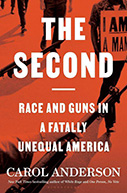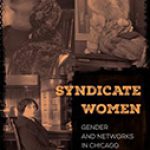The Second: Race and Guns in a Fatally Unequal America

Author: Carol Anderson
Publisher: Bloomsbury Publishing, 2021. 272 pages.
Reviewer: Staci L. Beavers ǀ June 2022
The fatal shootings of Philando Castile and Alton Sterling at the hands of police officers, hundreds of miles apart but within 48 hours of one another, shocked and horrified many, but they surely could not have surprised historian Carol Anderson. While police approached Alton Sterling in response to a tragically unfunny “prank call” (p. 2), Castile’s last moments particularly illustrate Anderson’s thesis all too well: a Black man exercising his legal right to carry a registered firearm was judged and executed within a few minutes of being pulled over by an officer. Afterward, the National Rifle Association, the most widely known and vocal defender of gun rights in America, notably had very little to say in defense of the rights of Black Americans to own and carry firearms (p. 3). So opens Carol Anderson’s The Second: Race and Guns in a Fatally Unequal America. As Anderson relentlessly demonstrates, these killings simply but clearly illustrate patterns of hypocrisy and inequality that date back to colonial America, this time within the context of the Second Amendment. Her thesis: Rooted in a bargain forced upon the nation by slaveholders and their supporters, the Second Amendment continues to be wielded as a weapon against African Americans.
Insisting that hers “is not a pro-gun or anti-gun book” (p. 8), Anderson instead views the Second Amendment as “quicksand for African Americans” (p. 7). Since its Founding-era ratification, “[r]egardless of how African Americans have engaged this right, it has been used against them” (p. 160). Anderson opens and closes the book by reminding the reader of a sampling of contemporary shootings of Black Americans in a dizzying array of separate-but-all-too-familiar scenarios. But she directs the reader’s focus to the historical roots of today’s policies and circumstances, particularly the origins of gun rights and the racial hypocrisy of the Second Amendment’s early history. She ties today’s Second Amendment landscape directly back to the United States’ foundational reliance on slavery, inequality, and oppression. As crafted, ratified, and applied over more than two centuries, Anderson argues that the Second Amendment continues to fulfill its original intent of maintaining and reinforcing white supremacy against Blacks.
The author takes the reader back to the Amendment’s colonial origins, detailing its fundamental purpose as entrenching slaveholder interests and white supremacy. Certainly the enslaved enjoyed no right to armed protection—they were instead the primary targets of the weapons. By the 1600s, several colonies prohibited even Free Blacks from owning the weapons seen as critical to protecting whites against the threats posed by anyone with dark skin, enslaved or free (p. 18, p. 163). Early armed militias were staffed through “the deputizing of all white males” (p. 13) within a given jurisdiction; among their primary missions was protecting the institution of slavery and its beneficiaries (pp. 34-35). White distrust and fears of slave uprisings were not unfounded. Anderson notes a number of almost-successful uprisings, whose near misses led to ever-more-brutal treatment of those consigned to inferior status. White distrust led to only reluctant arming of Blacks in some (but not all) states even when Revolutionary forces were most in need of able-bodied fighters; even at their most desperate, white leaders viewed armed Blacks as more threatening to their interests than the Redcoats (pp. 19-22).
With independence secured, leaders of the new nation turned their attention to internal battles. Slaveholders and their allies held the trump cards—protection of slaveholders’ interests would be “their price” for establishing a new government for the floundering nation (p. 26, citing Zahniser, 1967). Concessions to slavery extended well beyond the more obvious bargains such as the Three-Fifths compromise and the fugitive slave clause, but also included federal protection against “slave insurrections, euphemistically termed ‘domestic violence’” (p. 28). This provision required states that banned slavery to “assist in suppressing slave insurrections if the local militia couldn’t contain” them (p. 29).
Anderson describes protecting the right to bear arms as “not some hallowed ground but rather a bribe, paid … with black bodies” (p. 32). The Second Amendment debate focused not on self-defense or individual freedom, but was instead forced into the Bill of Rights by slaveholding interests “to ensure a role for militias to control the enslaved” (p. 86). Certainly Blacks’ self-defense was never in many framers’ sights as a right worth protecting. Rather, Madison proposed the Second Amendment to assuage concerns over slave revolts by denying the federal government the authority to interfere with slaveholding states’ militias and their relentless efforts to ensure white supremacy in law and in fact (pp. 32-33).
As the nation lurched towards Civil War, continued fears of uprisings, exacerbated by the Haitian Revolution and numerous almost-successful uprisings within the U.S. itself, inspired ever-more-ruthless tools and techniques to reinforce and strengthen American oppression of Blacks within its expanding geographic reach. For example, in what became Louisiana, “after the territory was purchased by the United States, whites demanded that all free Blacks be disarmed” (p. 60), including those who had previously served in local militias. Though armed Black soldiers served under Andrew Jackson at the Battle of New Orleans (pp. 68-69), the arming of free Blacks even to fight on behalf the U.S. remained reluctant and rare. Importantly, Anderson also sheds some light on happenings in non-slaveholding states in the years leading up to the Civil War. For example, she notes several northern cities that witnessed white mob attacks against Black neighborhoods during this period (p. 81). In 1841 Cincinnati, authorities disarmed Blacks and then left them defenseless in the face of white mob violence (pp. 79-80, citing Cottrol and Diamond, 1991; Woodson, 1916). While Anderson’s focus on happenings in slaveholding states makes sense, more attention to the rest of the U.S. and its expanding territories would have been welcome as well in order to flesh out the context for today’s nationwide disparities.
Post-Civil War Southern whites’ determination to deny newly-freed Blacks any meaningful rights of citizenship of course included denying them the right to basic self-defense. Many states passed restrictions specifically against Black gun ownership (p. 86). Black efforts to protect communities through both military service and private weapons ownership proved largely futile. Anderson briefly recounts numerous cases of white mob violence against Black communities from the Reconstruction and Jim Crow eras that went unpunished or in which the punishments meted out targeted Blacks who dared to defend their communities or themselves.
After directing the reader’s attention to official policies, practices, and events from Colonial America through Jim Crow, the author jumps to California’s 1967 backlash against African Americans’ openly carrying weapons in their Oakland neighborhoods. Governor Ronald Reagan, himself an ardent gun rights supporter, locked arms with the politically emergent National Rifle Association to support California’s Mulford Act. This new statute legally and politically disarmed the Black Panthers with its restrictions against openly carrying loaded guns. With the Black Panthers not-quite acknowledged as the law’s targets, Reagan insisted that this new law would only keep guns out of the wrong hands. But as Anderson notes, the Black Panthers were suddenly and deliberately recast from “law-abiding citizens” exercising their protected rights to being targets of gun law enforcement by the conscious decision of lawmakers and a gun-rights advocate wielding the Governor’s pen (p. 138). Again, jumping forward several decades, Anderson then brings the reader to the present by briefly describing a range of cases in which gun rights doctrines invariably were applied to justify violence against Black Americans, whether by police or private citizens. She closes the book with the political circus that immediately followed Kyle Rittenhouse’s shooting of three men in Kenosha, Wisconsin. (Fittingly, Rittenhouse was acquitted by a Wisconsin jury as I was reading Anderson’s book, and he appears to be launching a new career on the right-wing lecture and event circuit as I began this review.)
This book would be an especially good read for someone who is not well-versed in Black history, but who is interested in historical context for today’s policy debates and political battles. Reading Anderson’s brief volume, which packs plenty of wallop into just 165 pages of text, reminded me of listening to an episode of NPR’s Throughline. Each week, Throughline takes its listeners “back in time to understand the present” (https://www.npr.org/podcasts/510333/throughline). Similarly, Anderson’s work demonstrates parallels between past and present, and contextualizes how both contemporary policies and their applications tie back to the colonial era.
In addressing today’s landscape, Anderson recounts how numerous contemporary policies and practices have a disproportionately negative impact on African Americans. Examples include restrictions on gun ownership by those convicted of felonies, and heavy policing in urban areas mostly populated by Blacks. Doctrines such as “stand your ground” have in prominent cases effectively been weaponized to protect whites who shoot African Americans (p. 8), with Trayvon Martin as the most prominent victim of such a law. Similarly, the “castle doctrine” failed both Kathryn Johnston (p. 142) and Breonna Taylor (p. 144), just as open carry protections failed Tamir Rice, who carried only a plastic toy (p. 155).
While Anderson doesn’t make this point explicitly, a different historical parallel kept coming to mind as I read her work. America’s early decision to chart its course based on an economic dependency on slavery clearly reverberates still in today’s ongoing social, economic, and political disparities. But it also feels on-point in America’s current unwillingness to steer away from its dependence on fossil fuels, even as the impact of climate change accelerates. Now as then, the nation’s leaders know the existential costs of our current path, yet short-term economic gain for some again dictates devastating costs paid by the many. This time, the fate of the entire planet hangs in the balance.
As a political scientist, I typically anticipate that articles and books will close with at least a modicum of solution-focused discussion or a few policy proposals that hint at “where we go from here.” The abrupt closure of this volume with no such discussion left me a bit at loose ends. Given how exhausting and discouraging Carol Anderson’s work was to read and contemplate, I cannot pretend to imagine how it must have felt to research and write it. But her work provides an important perspective on some of the existential issues of our day, so it’s worth investing the time and mental energy.
References
Cottrol, R.J. and Diamond, R.T. (1991). The Second Amendment: Toward an Afro-Americanist reconsideration. Georgetown Law Journal 80(2) (1991), 309-361.
Woodson, C.G. (1916, January). The Negroes of Cincinnati prior to the Civil War. Journal of Negro History 1(1), 1-22.
Throughline (n.d.). National Public Radio. Retrieved at https://www.npr.org/podcasts/510333/throughline
Zahniser, M.R. (1967). Charles Cotesworth Pinckney: Founding Father. University of North Carolina Press.
Staci L. Beavers is a Professor of Political Science at California State University San Marcos.


